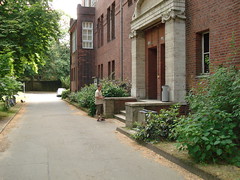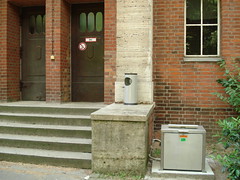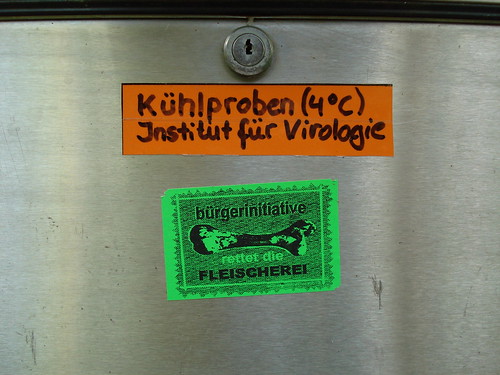 Yesterday morning, before our session on art and science, I took a walk through the beautiful old Charité area — now one of the joint medical campuses of Humboldt Universität and Freie Universität — with 19th and early 20th century buildings spread out in a large park.
Yesterday morning, before our session on art and science, I took a walk through the beautiful old Charité area — now one of the joint medical campuses of Humboldt Universität and Freie Universität — with 19th and early 20th century buildings spread out in a large park.
When I passed by one of the buildings that houses some of the veterinary medical departments, an aluminium-box to the right of the entrance caught my eye.
Went closer and discovered a small handwritten red label on the front of the box:
‘Refrigerated samples (4o)
Institute of Virology’
Apparently it’s a refrigerated drive-in (or walk-by) virus sample delivery box:

I asked a man who was standing smoking outside the building to open the lid to demonstrate how it works:

My anonymous assistant had no attachment to the veterinary virology department, so he couldn’t really explain how the box is (was) used. What kind of samples are (were) delivered here? By whom? A night-delivery box? What kinds of tests? And how does (did) the sender get the information back? Is (was) it a foot-and-mouth disease sample emergency delivery box?
And then I saw that someone has glued a green label below the official one:

‘bürgerinitiative / rettet die fleischerei’ (‘citizen initiative / save the butcher-shops’).
One of these witty anti-establishment micro protests and art installations which has made the Berlin autonomous movement world famous. Perhaps a vegan tongue-in-cheek criticism of a food industry which would be in serious trouble if institutes of virology weren’t producing knowledge that kept animals alive for later slaughter and sale.
A nice item for acquisition if we were a museum responsible not only for human medicine but also for understanding and displaying veterinary medicine as well.
Refrigerated drive-in virus sample delivery box carrying an anti-science-food-industry micro protest art installation.
Yesterday morning, before our session on art and science, I took a walk through the beautiful old Charité area — now one of the joint medical campuses of Humboldt Universität and Freie Universität — with 19th and early 20th century buildings spread out in a large park. When I passed by one of the buildings that houses some of the veterinary medical departments, an aluminium-box […]


